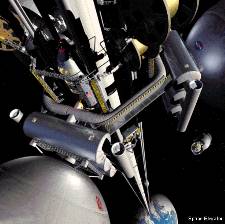|
|


TechnoFILE is copyright and a registered trademark © ® of
Pandemonium Productions.
All rights reserved.
E-mail us Here!

Sci Fi Concept May Be Your Ticket Into SpaceBy Jim Bray Get ready to spend a weekend at "the Orbiter Hilton," a luxury hotel perched in outer space. Okay, it isn't going to happen next week, or even next decade, but there's a definite move afoot to bring the cost of space travel down to earth, so to speak, allowing just about anyone with stars in his or her eyes to travel into space. You wouldn't have to put up with the chest-hammering experience of a rocket launch, either. Instead, you'd ride comfortably in a “space elevator,” a concept first thought to have been imagined in 1895 when Russian scientist Konstantin Tsiolkovsky dreamed of an Eiffel-like tower that would be topped by an orbiting "celestial castle." The idea became more mainstream a little more than twenty years ago in science/science fiction writer Arthur C. Clarke's novel "The Fountains of Paradise." You may remember Mr. Clarke from "2001: a Space Odyssey," but he's also the man whose fertile mind was responsible for dreaming up those now-ubiquitous communications satellites that are revolutionizing our world - so even though the space elevator may sound more than a bit far fetched, it isn't safe to write off Clarke’s ideas as the ramblings of just another whacko. It probably isn't time to dump your shares in aerospace companies just yet, however. The idea is to build a platform out in geo-stationary orbit, about 24,000 miles up, where it remains forever poised over the same spot on the Earth. To this platform would be attached a pair of "super cables," one of which runs back to the ground and contains the actual space elevator. The other cable would extend much farther out into space, for balance and, believe it or not, would be anchored to a captured asteroid. Pretty far out, isn't it? It's thought that the groundside end of the cable would be tethered to a thirty mile tall tower on an isolated artificial island built in an equatorial region of ocean. This location would ensure the island is directly under the orbiting platform as well as giving the huge cable a relatively safe place to splash down should the unthinkable happen. The trip up and down the space elevator, which would take about five hours, wouldn't be like standing in those claustrophobic boxes we use in today's buildings and towers but rather, according to artists’ conceptions, would be more like travelling in a small train that zips up and down to and from orbit. The space elevator's proposed electromagnetic propulsion system already exists, though undoubtedly in more primitive form. Maglev (Magnetic levitation) trains, which are currently being experimented with as high speed people movers of the near future, hover over their tracks and are propelled along by powerful magnets. The technology is also the driving force behind the thrill ride "Superman, the Escape," at California's Six Flags Magic Mountain amusement park. As far as ticket prices are concerned, the bright people pushing the space elevator figure that such a transit system could lower the cost of putting cargo or, better still, people into space from an estimated $10,000 per pound to about $5. That's powerful incentive to build - and it could go a long way toward jump starting the world's almost-stalled manned space program. Naturally, it's going to cost a bundle to build the thing in the first place, but the people driving the idea claim it could transform human society in much the same way the building of railroads and highways opened up the world to travel and commerce. That's a pretty potent claim, and one that only history will be able to judge, but it goes to show the incredible potential of bringing the costs of space down to earth. The sky would literally be the limit, and would be open to tourism, commercial research and development, and manufacturing. In fact, any business or discipline that could make use of the advantages of a low or zero gravity environment would benefit from an elevator to the stars. Construction of the space elevator would also create a whole variety of new investment opportunities, from companies advancing the state-of-the-electromagnetic-propulsion art to those creating new tech construction materials and, well, maybe even good old Otis Elevators…. It’s an exciting concept, though building it is sure to have its ups and downs! Jim Bray's technology columns are distributed by the TechnoFILE and Mochila Syndicates. Copyright Jim Bray.
|
|
|
| Support TechnoFile via Paypal |
| TechnoFILE's
E-letter We're pleased to offer our FREE private, subscription-based private E-mail service. It's the "no brainer" way to keep informed. Our Privacy Policy |